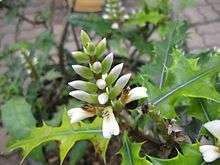Acanthus ebracteatus
Acanthus ebracteatus is a species of shrubby herb that grows in the undergrowth of mangroves of south-east Asia. Common names include sea holly and holly mangrove.
| Acanthus ebracteatus | |
|---|---|
 | |
| Scientific classification | |
| Kingdom: | Plantae |
| Clade: | Tracheophytes |
| Clade: | Angiosperms |
| Clade: | Eudicots |
| Clade: | Asterids |
| Order: | Lamiales |
| Family: | Acanthaceae |
| Genus: | Acanthus |
| Species: | A. ebracteatus |
| Binomial name | |
| Acanthus ebracteatus Vahl | |
| Subspecies | |
|
A. ebracteatus subsp. ebracteatus | |
Description
It grows as an erect, spreading or scrambling shrubby herb, up to 1.5 metres tall, usually with a great many stems. Its leaves are dark green, stiff, with sharp spines at the end of each deep lobe: very much like those of holly (Ilex). Flowers are blue, purple or white, and occur in spikes terminal on the branches. The fruit is a square-shaped capsule, which explodes when ripe, projecting the seeds up to two metres from the plant. Seeds are off-white and flat.
Taxonomy
This species was first described by Martin Vahl in his 1791 Symbolae Botanicae. In 1806 Christiaan Persoon transferred it into Dilivaria, but this was not accepted.
Two subspecies are recognised, the autonym A. ebracteatus subsp. ebracteatus, and A. ebracteatus subsp. ebarbatus, described in 1986.
Distribution and habitat
It occurs in the undergrowth of mangroves in south-east Asia, including northern Australia.
Medicinal uses
The leaves of Acanthus ebracteatus, noted for their antioxidant properties, are used for making Thai herbal tea in Thailand and Indonesia.[1]
References
- Chan, E.W.C.; Eng, S.Y.; Tan, Y.P.; Wong, Z.C.; Lye, P.Y.; Tan, L.N. (2012). "Antioxidant and Sensory Properties of Thai Herbal Teas with Emphasis on Thunbergia laurifolia Lindl". Chiang Mai J. Sci. 39 (4): 599–609.
- "Acanthus ebracteatus Vahl". FloraBase. Western Australian Government Department of Parks and Wildlife.
- "Acanthus ebracteatus Vahl". Australian Plant Name Index (APNI), IBIS database. Centre for Plant Biodiversity Research, Australian Government.
- http://mangrove.nus.edu.sg/guidebooks/text/1045.htm
External links
- "Acanthus ebracteatus Vahl". Atlas of Living Australia.